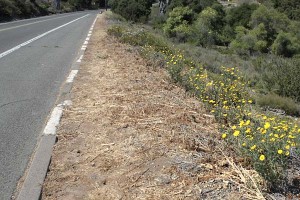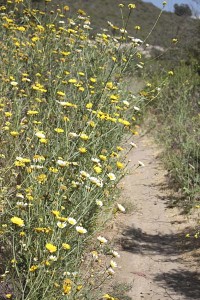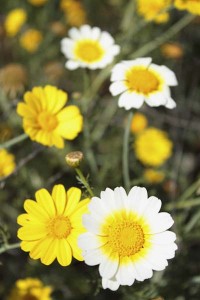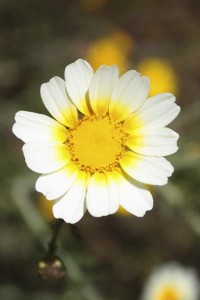All around town, both roadside and trailside, the garland chrysanthemums have been blooming.
The perky spawn of plants that have been grown for centuries in China and Japan for their tasty young green leaves, Chrysanthemum coronarium has come to be a big nuisance in many disturbed areas of Southern California.
But rather than getting all negative and cursing the plant, let me try a different tack to try to encourage everyone to rip it out by its pretty little roots:
Did you know that 100 grams of boiled garland chrysanthemum provides 51% of your recommended daily requirements of vitamin A, 40% of vitamin C, 21% of iron, and has only 20 calories? (That’s according to healthalicious.com.)
OregonLive.com offers some kitchen ideas for garland chrysanthemum: “Lightly saute the leaves and stems or whole 4- to 6-inch seedlings with sesame seeds, garlic, ginger and soy sauce… Eat raw in salad, add to soups containing fresh ginger, or dunk in fritter batter and deep-fry.”
(Be sure your greens come from a site other than a roadside that might have been sprayed with herbicides by the city. And be sure you’re eating garland chrysanthemum instead of the somewhat similar bush sunflower (encelia) or San Diego sunflower (viguiera).)
There are of course other reasons to pull up this plant. The Tijuana River National Estuarine Research Reserve site puts it succinctly: “[C]hrysanthemum forms fields that overtake native plants such as California buckwheat and sagebrush–both these plants provide food and shelter for native birds, insects and other animals.”
So in the end garland chrysanthemum is the perfect weed. Whether you respond to thoughts of a healthy snack or to appeals of doing what you can to make the world a better place, you can get out your weeding tools and go to town.
A final thought: Wouldn’t it be great for green-conscious restaurants to offer tasty and hip entrees on their menu that contain locally-harvested garland chrysanthemum greens that otherwise would have been damaging the ecosystem? Or maybe we could stock stalls at farmer’s markets with piles of the stuff? Why not turn this over-abundant invasive plant into a resource that could be cropped, improving the local landscape at the same time?
Eat up, everyone!
This post is dedicated to Outofdoors, who first thought up the idea of dedicating the 13th of the month to posts on invasive species.






I had no idea this plant was a problem in So Cal. I’ve only read about it in Chinese recipes, but I hadn’t ever gotten the nutrition breakdown. (I was thinking this plant might be the trad Chinese remedy for heat, but I looked it up: that’s C. morrifolium.) I like your idea for clearing invasives by using them as exotic restaurant food (or in our larders). If we’ve come this far on recycling in the last 20 years, why not move ahead on stuff like this? It also helps create local industry…
Pretty flower and it’s neat that it can be cooked, eaten raw, and should be by the sound of it. I have a problem in my yard with a plant called Multiflora rose. I want to get rid of it but my mom like the flowers.
Don’t forget the pesky Dandelion! There’s another option in the tasty weed “journal of fine eats”. Or Kinnikinnik, Indian Tobacco as it is known in the North West.
I also had no idea the “mum” was such a nuisance, James. It serves you right for living in Paradise. 😉
Did you know garland chrysanthemum goes for $20 a pound?
I thought it best to start the rumor right away.
Pomona, I think the idea came to me straight out of recycling and reusing. Putting them on a menu would raise awareness even if people didn’t particularly care for them. But with centuries of cookery behind them, they really must be delicious.
Charles, it’s tough when people get attached to the pretty flowers! And the garland chrysanthemum has pretty flowers combined with tasty greens. I hope we’re not doomed to have it forever.
Steve, ah the amazing dent de lion–superbe! Such troubles here in paradise. Yes we can eat some of our noxious weeds, though not far from the first stand of chrysanthemum was a superb stand of poison hemlock. I wouldn’t suggest the same grazing strategy with those…
Wiseacre, I like the way your mind works! I’m sure the $20 was the sale price.